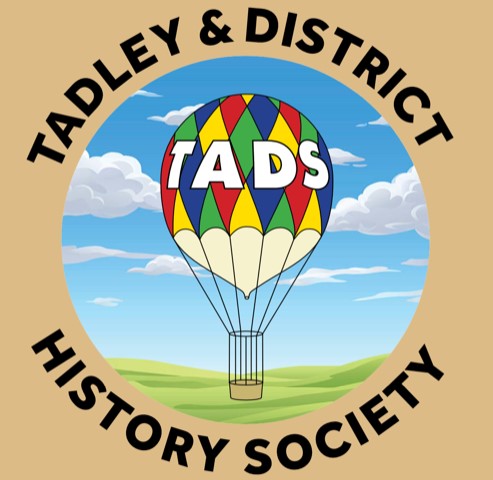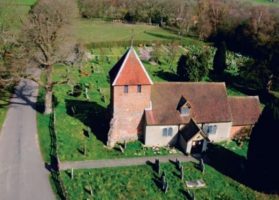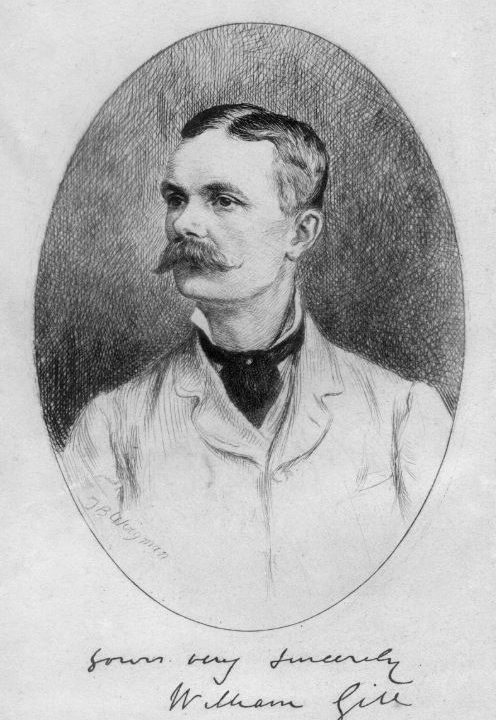TADS Online Talk held at 8pm on Wed 6th May 2020.
By Tony Hadland
May 2020 Newsletter – Review of the Talk
Tony’s book about William Gill is now out of print, but it may be downloaded as a pdf from Tony’s website https://hadland.wordpress.com/category/william-gill/ .
Much of the book quotes Gill’s own words. The link to get the pdf can be found at the bottom of the page.
Oral family tradition said that Tony was related to someone famous. It took many years to prove it, but it was his Great, Great Uncle William Gill who was born in Bangalore, India in 1843 to an Indian Army family. William and his siblings came to England for schooling accompanied by their Mother, leaving their father in India and free to take two Indian mistresses who bore him more children and he never did return to England. William went to Brighton College where he was a good scholar and left in 1861 to join the Royal Engineers at the Royal Military Academy at Woolwich.
It seems that he remained attached to the Army, but never in regular postings. An 1869 sketch book shows that he visited Scotland and was a competent artist. Shortly after that he visited India, and on his return a distant relative left him a real fortune and this was key to his travels. (He still had £7 million at the time of his death).
Aged 30, his first expedition was to Georgia, Azerbaijan, and Persia (Iran) with the experienced traveller Valentine Baker. Tony’s map showed that they went all over the place, a real baptism of fire. On his return home Gill stood as Tory candidate for Hackney which was then a safe Liberal seat. He did well but was not returned and a second attempt to be an MP in Nottingham was also unsuccessful.
With plenty of money he was free to do what he wanted, so when a friend he met in Trafalgar Square mentioned China that is where he went next. First he went to Berlin to consult an expert on China, Baron Ferdinand Richthofen, whose nephew is more famous – the ‘Red Baron’, the WWI German ace fighter pilot. From Berlin, Gill went straight off to China via Marseilles and Hong Kong to Tianjin and Peking (Beijing). He was now aged 32. His expedition was also for gathering Military Intelligence. He made a five week expedition seeing the Great Wall, going to Inner Mongolia and back to Peking. He made lots of sketches on route and sent his diaries back to London by post! The sketches were made into drawings by professional artists in London and used to illustrate his books.
He had intended to return home from China overland but diplomatic relations with Russia were unsettled, so instead he went up the Yangtze River, around the edge of Tibet and down through Burma. He received help from French Catholic Missionaries. His book illustrations show bridges, scenery and lots of small roadside Joss Houses (small shrines not doss houses) The travelling party was Gill, a servant, a dog, a pony, a pony boy and 20 coolies for the luggage. The luggage apparently included good supplies of Worcester Sauce, an essential for travelling Victorian gentlemen. From Chengdu, he made a 400 mile circuit in the mountains of Sichuan which was all new to Westerners.
As he had been travelling rather light, the number of coolies was increased to 60 for the main expedition and he had a new companion called Mesny a Jersey man who had gone native. While travelling on the Tibetan Plateau they were at an elevation of nearly 15,000 ft. They surveyed the whole route, later publishing maps at a scale of 2 miles to the inch, as well as the books with their copious illustrations.
On his return to London Gill was awarded a medal by the Royal Geographical Society and another medal by the French. He was also appointed a Military Intelligence Officer. On the strength of these journeys he was sent to Russian occupied Romania with a friend. Their cover was very thin and they were arrested and thrown out.
Next was a short trip to Constantinople (Istanbul) where he again met Valentine Baker, who was now working for the Turks. In 1880 Gill was asked to report to the Government on the strength of the Chinese Army. The note books came in very handy and he concluded that their strength was far from great. Do you know that great big lion in the Forbury Gardens in Reading? It commemorates the many men of the Royal Berkshire Regiment killed at Maiwand in Afghanistan in August 1880. (British armed forces have never done well out there). Gill was sent to help the survivors of the Anglo Indian forces who were holed up in Quandahar. Travelling by train and ferry he was too late for the relief of the city, so he joined an expedition into Pakistan and afterwards went solo to Turkmenistan. The Russians noticed and complained, so London called him home. He returned by way of Moscow!
In 1881 he went on a self-financed intelligence gathering mission to North Africa. In 1882 he went on what was to be his final journey, this time to Egypt with a Professor Palmer as an advisor. He was told to liaise with the Bedouins. They found that nationalists were tapping into an important telegraph line, so they decided to cut it. But they were betrayed and all the party were executed out in the desert. There was a huge search to find out what had happened. Bones and other things were recovered and brought home to England.
On Wednesday 4th of April 1883, the Gill party was buried at St. Paul’s cathedral in London. William Gill was only 38 years old. Was the party’s cook the only Jew ever buried in St. Paul’s wondered Tony? William Gill is commemorated in Memorials and Scholarships at Brighton College and by a Royal Geographical Society Medal. The Royal Geographical Society hold all of Gill’s numerous diaries.
_____________________________________
NB. I have mostly used the spelling of place names used by the speaker. Names do vary over the years and I hope they are understandable.
Review by Richard Brown


